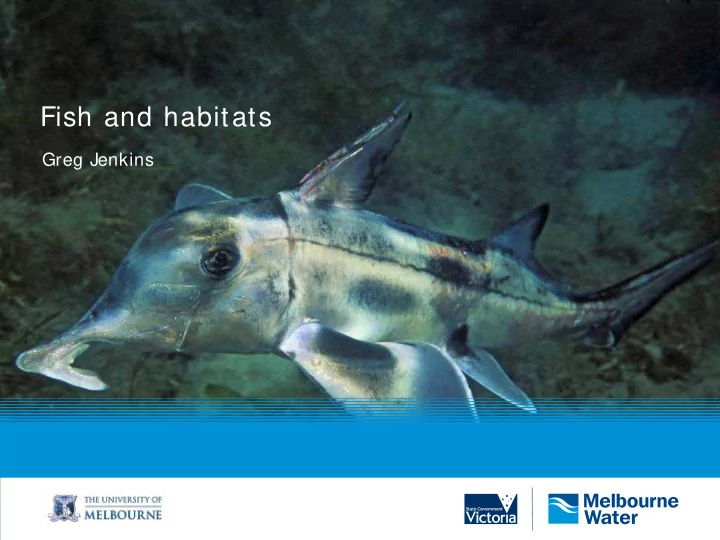

Fish and habitats Greg Jenkins
Background • At present, fish assemblages are only well studied in Zostera seagrass. • We are unsure whether key species are reliant on specific habitats or whether alternative habitats can be utilised • This means the resilience of fish populations to habitat loss and the need for protection of specific habitats to support fish populations is unclear
Objectives • To determine the specificity of fish habitat relationships in Western Port • To determine the resilience of fish populations to habitat loss through the use of alternative habitats • Improving understanding of the important values and resilience of specific asset areas already identified in Western Port from the perspective of fish biodiversity
Sampling sites + Amphibolis Bryozoan Caulerpa Rhodoliths + Reef/algae
Amphibolis
Caulerpa
Rhodoliths
Reef/algae
Bryozoan
Stereo-video sampling
Mini Otter-trawl sampling
Dominant fish species - Amphibolis
Ornate Cowfish - Flinders
Old Wife - Flinders
Sixspine Leatherjacket – Flinders
Little Weed Whiting – Flinders
Weedy Seadragon – Balnarring
Calamari – Point Leo
Dominant fish species – Reef/Algae
Silver trevally – Cat Bay
Gummy shark, Snook – Cat Bay
Dominant fish species – Caulerpa
Key fish species – Caulerpa
Fish species – Rhodoliths
Octopus – Rhodoliths
Fish species – Bryozoan
MDS plot comparing fish assemblages Standardise Samples by Total Transform: Log(X+1) Resemblance: S17 Bray Curtis similarity SeasonLocation 2D Stress: 0.05 Autumn Balnarring Spring Balnarring Autumn Cat Bay Spring Cat Bay Autumn Pt Leo Spring Pt Leo Autumn Flinders Spring Flinders
Differences between locations and seasons • Balnarring and Flinders were distinctive for bridled leatherjackets and weedy seadragons • Cat Bay and Pt Leo were distinctive for bluethroat wrasse. • Cat Bay was distinct from Point Leo in relation to silver trevally • Autumn was characterised by bridled and six-spine leatherjackets while spring was distinct for weedy seadragons
Conclusions • Amphibolis and Caulerpa had diverse and abundant fish assemblages comparable to Zostera • The assemblage of fish in Caulerpa was more similar to that in Zostera • Caulerpa , and to a lesser extent Amphibolis , may act as a refuge habitat in the case of Zostera loss • The nursery value of these habitats may be lower due to greater depth (both species) and exposure ( Amphibolis ) • Weedy seadragons appear to have a relatively specific requirement for Amphibolis beds on low profile sand/ reef
Acknowledgements Field work assistance: Brent Womersley, Tim Kenner, Andrew Brown Laboratory assistance: Tim Kenner Still photographs: Julian Finn, Mark Norman (MoV) Peter Macreadie (UTS) Funding: Melbourne Water Department of Sustainability and Environment Port Phillip Bay and Western Port Catchment Management Authority
Recommend
More recommend